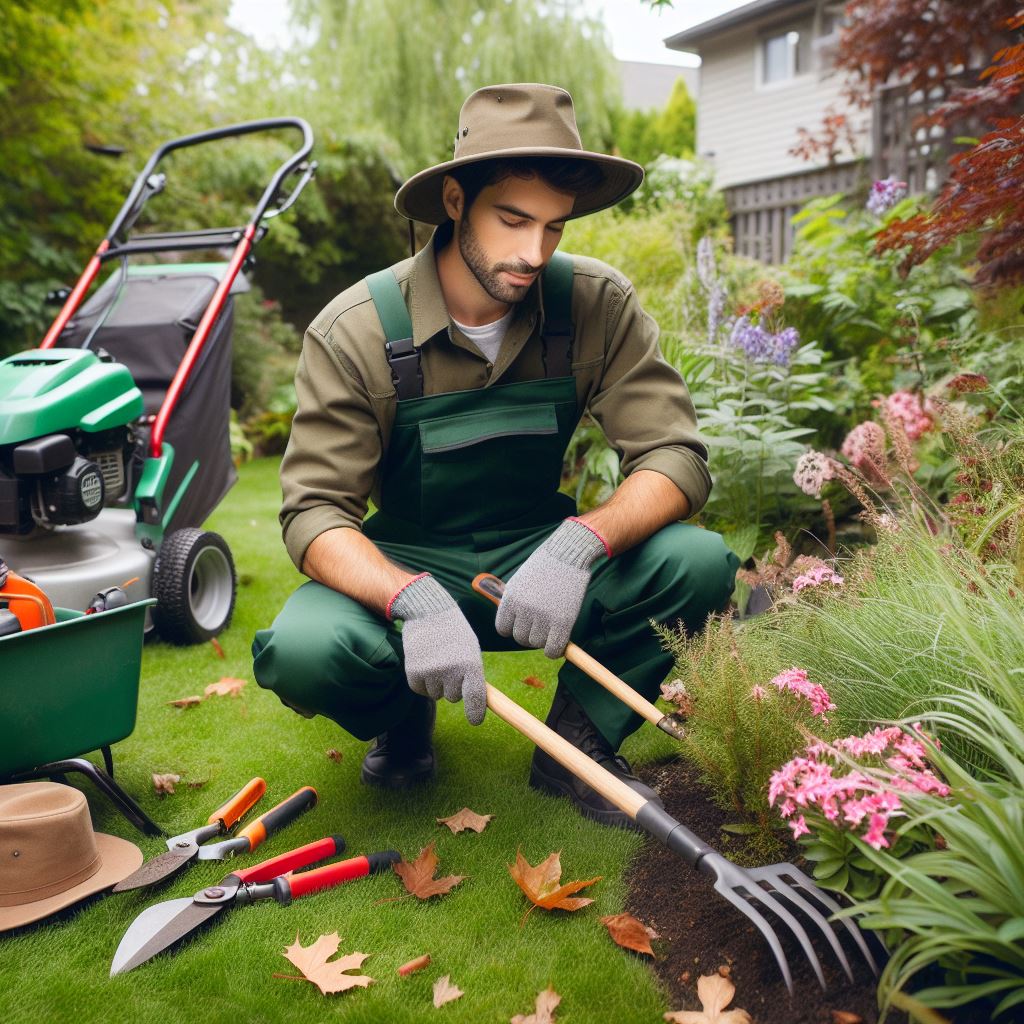Introduction
A. Budget Landscaping
Revamping your yard doesn’t need to break the bank. Budget landscaping offers cost-effective solutions for a stunning outdoor space.
B. Importance of Saving Money
Saving money in your yard is not just about frugality; it’s a smart investment.
Enhancing your outdoor space shouldn’t compromise your financial well-being.
C. Purpose of the Blog Post
This section unfolds practical strategies for budget-friendly landscaping.
Discover tips, DIY hacks, and creative ideas to transform your yard without emptying your wallet.
Let’s embark on a journey to elevate your outdoor haven affordably.
Assess Your Yard
In order to effectively save money in your yard, it is crucial to first assess your yard before beginning any landscaping project.
By doing so, you can identify specific needs and challenges, as well as determine your landscaping goals.
A. Significance of Assessing Your Yard
Assessing your yard before starting any landscaping project is significant for several reasons:
- Understanding the size and dimensions of your yard is essential for proper planning.
- Identifying any existing issues such as drainage problems or uneven terrain helps in creating effective solutions.
- Determining the amount of sunlight or shade in different areas can influence your plant choices.
- Assessing the existing vegetation and soil quality allows you to determine what improvements are necessary.
B. Tips and Guidelines for Assessing Your Yard
When assessing your yard, consider the following tips and guidelines:
- Measuring the area: Begin by measuring the dimensions of your yard, including both the width and length. This will help you calculate the amount of materials needed.
- Identifying specific needs and challenges: Take note of any specific needs in your yard, such as areas that receive excessive shade or places prone to erosion. This will help you address these challenges during your landscaping project.
- Determining your landscaping goals: Decide on the overall goals and vision you have for your yard. Whether it’s creating a play area for children or a peaceful garden retreat, understanding your goals will guide your design choices.
- Assessing soil quality: Test your soil to understand its composition and fertility. This will help you determine if any amendments or fertilizers are needed for optimal plant growth.
- Analyzing sunlight and shade: Observe the movement of the sun throughout the day to identify areas of full sun, partial shade, or deep shade. This knowledge will aid in selecting appropriate plants for each area.
- Evaluating drainage: Determine how water flows in your yard during rain or irrigation. Look for areas that may cause water accumulation or drainage problems, and strategize ways to address them.
- Assessing existing vegetation: Take stock of the current plants and trees in your yard. Consider which ones you want to keep, remove, or relocate as part of your landscaping plans.
- Considering maintenance: Think about the level of maintenance you are willing to commit to. Choose plants and features that align with the amount of time and effort you can dedicate to their upkeep.
By following these guidelines and thoroughly assessing your yard, you can effectively plan and execute your budget landscaping project.
Understanding the specific needs and challenges of your yard will help you save money and create a beautiful outdoor space.
Read: Landscaping Certifications: What Canadians Need
Plan Your Landscape Design
A well-planned landscape design can save you money in your yard.
Don’t underestimate its importance.
To effectively plan your landscape design and maximize your savings, follow these steps:
A. Researching Different Landscaping Ideas
Begin by researching different landscaping ideas that suit your style and preferences.
Look for inspiration and gather a variety of options.
Consider factors like the plants you want, the overall layout, and any specific features you desire.
B. Sketching Your Design
Once you have a better understanding of your vision, put it on paper.
Create a sketch of your landscape design.
Map out the various elements, such as flowerbeds, walkways, and seating areas.
This will help you visualize the final result.
C. Considering Practical Elements
Don’t forget to take practical elements into account when planning your landscape design.
These considerations can significantly impact your budget savings.
Unlock Your Career Potential
Visualize a clear path to success with our tailored Career Consulting service. Personalized insights in just 1-3 days.
Get Started- Sun Exposure: Take note of how much sun each area of your yard receives throughout the day. This will help you determine where to place sun-loving or shade-loving plants, saving you money on plants that might struggle in certain spots.
- Soil Type: Evaluate the type of soil in your yard. Different plants thrive in various soil conditions. By understanding your soil’s composition, you can choose plants that will flourish without costly soil amendments.
- Water Accessibility: Analyze the access to water in your yard. Consider installing a rainwater harvesting system or utilizing water-efficient irrigation methods to reduce your water bill.
- Maintenance Requirements: Think about the maintenance needed for your design choices. Opting for low-maintenance plants and features will not only save you time but also reduce future expenses.
- Long-Term Growth: Plan for the long-term growth of your landscape. Ensure that you leave enough space for plants to mature and spread without overcrowding, which would require costly adjustments later.
By carefully considering these practical elements during your planning phase, you can make informed decisions that will save you money in the long run.
Remember, the key to budget landscaping is investing time and effort upfront to plan and design your yard thoughtfully.
With a well-planned landscape, you can enjoy both the aesthetic beauty and the financial benefits for years to come.
Read: Starting Your Landscaping Business in Canada
Choose Cost-Effective Materials
A. Cost-Effective Materials for Landscaping
- Mulch: a popular and affordable option that helps retain moisture and suppress weed growth.
- Gravel or crushed stone: provides a decorative touch while being cost-effective and low maintenance.
- Native plants: require less water, fertilizer, and maintenance compared to non-native species.
B. Benefits of Using Cost-Effective Materials
Using cost-effective materials in your landscaping projects can offer several advantages:
- Affordability: Cost-effective materials save you money, allowing you to create a beautiful yard on a budget.
- Low maintenance: These materials often require less upkeep, reducing the time and effort spent on yard work.
- Environmental benefits: Native plants help support local ecosystems and attract beneficial wildlife.
C. Tips for Purchasing Cost-Effective Materials
Finding cost-effective materials for your landscaping endeavors doesn’t have to be a challenge.
Follow these tips:
- Shop around: Compare prices from different nurseries, home improvement stores, and online retailers.
- Buy in bulk: Purchasing materials in larger quantities often results in lower costs per unit.
- Consider local sources: Look for nearby suppliers or community programs offering discounts on plants and materials.
- Utilize online marketplaces: Websites like Craigslist or Facebook Marketplace may have affordable options available.
- Attend plant exchanges or sales: Local gardening clubs and organizations often host events where you can find affordable plants.
By selecting cost-effective materials for your landscaping projects, you can achieve an attractive and well-maintained yard without breaking the bank.
With the variety of options available, there’s something suitable for every style and budget.
Read: Seasonal Landscaping: Tips for Canadian Climates

DIY vs. Hiring Professionals
A common dilemma when it comes to budget landscaping is whether to tackle the project yourself or hire professionals.
There are pros and cons to consider for both options.
A. Weigh the pros and cons of doing the landscaping project yourself versus hiring professionals
- DIY Pros: Cost savings is a significant advantage when doing the landscaping project yourself. You can potentially save a considerable amount of money by not paying for professional services.
- DIY Cons: Lack of expertise and experience may lead to mistakes that can be costly to rectify. Time and effort required for a DIY project should not be underestimated.
- Hiring Professionals Pros: Professionals have the knowledge, skills, and experience to design and execute landscaping projects efficiently. They can bring creative ideas and provide a polished finish.
- Hiring Professionals Cons: Hiring professionals can be expensive. The overall cost may include design fees, labor charges, and material expenses, which may exceed a DIY budget.
B. Situations in which DIY might be more cost-effective, and when hiring professionals makes sense
- DIY Cost-Effective Situations: For simple landscaping tasks like planting flowers or laying mulch, DIY is more cost-effective. Small projects that require basic skills are ideal for DIY enthusiasts.
- Hiring Professionals Makes Sense: For complex projects such as installing irrigation systems or constructing retaining walls, hiring professionals is recommended. Their expertise ensures proper execution and long-term functionality.
C. Tips for successful DIY landscaping to save money
- Start with small projects: Begin with manageable tasks that match your skill level. This allows you to learn and build confidence while avoiding costly mistakes.
- Utilize online resources and tutorials: Take advantage of numerous online articles, videos, and step-by-step tutorials that provide guidance and landscaping tips. These resources can help you plan and execute your project effectively.
- Seek advice from experienced gardeners or landscapers: Engage with experienced individuals who share their knowledge and insights. They can offer advice on plant selection, layout, and maintenance, preventing costly errors.
With careful consideration of the pros and cons, you can decide whether to embark on a DIY landscaping project or hire professionals.
By choosing the right path for your specific needs, you can save money and create a beautiful yard that reflects your personal style.
Read: Eco-Friendly Landscaping Tips in Canada
Maintenance and Upkeep on a Budget
A well-maintained yard not only enhances the beauty of your home but also helps you save money in the long run.
Neglecting your yard can lead to costly repairs and replacements.
Therefore, it is crucial to prioritize regular maintenance to ensure a budget-friendly landscape.
A. Importance of Maintaining Your Yard to Ensure Long-Term Cost Savings
- Prevents Costly Damage: Regular maintenance helps identify and address issues before they escalate into expensive problems.
Detecting a small leak or crack in your irrigation system early on can save you from major repairs later. - Extends Lifespan of Materials: Proper care and maintenance can significantly increase the lifespan of your outdoor elements.
Regularly cleaning your deck, for example, can prevent rotting and make it last longer, avoiding the need for costly replacements. - Preserves the Health of Plants: Consistent upkeep of plants and trees not only keeps your yard looking attractive but also maintains their health.
Pruning and trimming help prevent disease, pests, and overgrowth, saving you the cost of replacing them. - Enhances Energy Efficiency: Well-maintained landscaping can enhance energy efficiency in your home.
Strategic placement of trees and shrubs can provide shade during the summer, reducing the need for excessive air conditioning and lowering utility bills.
B. Practical and Budget-Friendly Maintenance Tips
- Regular Weeding and Pruning: Weeds compete with your plants for nutrients and water, leading to stunted growth.
Regularly weed your yard to keep them under control. Similarly, pruning promotes healthy growth and prevents overcrowding. - Proper Watering Techniques: Water your lawn and plants deeply but infrequently to encourage strong root systems.
Early morning watering helps minimize evaporation, saving water and reducing your water bill. Avoid overwatering, as it can lead to wasted resources and potential damage. - Using Homemade Organic Fertilizers: Instead of purchasing expensive fertilizers, consider making organic ones at home.
Composting kitchen scraps and using them as a natural fertilizer not only saves money but also benefits the environment.
Additionally, grass clippings can act as a nutrient-rich mulch when spread over flower beds and vegetable gardens. They provide natural weed suppression, retain moisture, and promote healthy soil. - DIY Yard Maintenance: Many tasks can be done by the homeowner without hiring professionals.
Regularly mowing the lawn, cleaning debris, and removing fallen leaves are simple tasks that can save you money by avoiding the need for outside help. - Proper Tool Maintenance: Take care of your yard tools so that they last longer, reducing replacement costs.
Clean your tools after each use and store them properly. Regularly sharpening mower blades and pruning shears ensures efficient performance.
C. Additional Tips
- Mulching: Applying mulch helps retain moisture in the soil, reducing the need for frequent watering. It also prevents weed growth, thus minimizing maintenance efforts. Mulching with organic materials like wood chips or straw can be a cost-effective solution.
- Utilize Rainwater: Investing in rain barrels or cisterns allows you to collect rainwater and use it for watering your plants and lawn. This reduces your dependence on municipal water and helps lower your water bill.
In a nutshell, maintaining your yard is essential for long-term cost savings.
By implementing budget-friendly tips for regular upkeep, you can preserve the beauty, health, and functionality of your landscape while keeping your wallet happy.
Conclusion
Budget landscaping is a great way to save money while still creating a beautiful outdoor space.
By following the tips and tricks we’ve provided in this blog post, you can create a stunning yard without breaking the bank.
Remember to add more details, use subheadings, include examples, and provide actionable tips.
Use visuals such as images, videos, or infographics to make your blog post more engaging and easier to understand.
Don’t forget to include statistics and provide additional resources for further guidance on budget landscaping.
By implementing these budget-friendly landscaping practices, you can create a beautiful outdoor space that you can enjoy with your family and friends.
So, what are you waiting for?
Get started on your budget landscaping project today!




